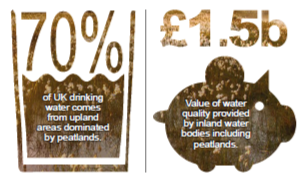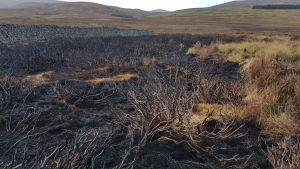“There appear to be few downsides to peatland restoration and a real potential for cost savings in providing long term public water supply. Peatland restoration offers a more sustainable future in water quality terms, as we’re addressing the causes of poor water quality, not treating the worsening symptoms.” Andrew Walker, Catchment Manager, Yorkshire Water
Peatlands are the headwaters for some of the UK’s major water supply areas (e.g. the peatlands of the Peak
District providing water to Manchester and Sheffield) and the river corridors of lowland peatlands (such as The
Broads) provide areas of water storage within the natural floodplain.
Up to 70% of UK drinking water is sourced from catchments dominated by peatland habitat (Natural England, 20091). Water derived from healthy peatlands is naturally of high quality with few pollutants and low nutrient levels, requiring straightforward treatment once it reaches a water treatment plant.
However, over the last 30 years, the amount of dissolved organic carbon, which creates the brown colour of peaty water, has doubled across many UK catchments (Yallop et al., 20102). Whilst some of this increase
relates to decreasing acid pollution, there is also evidence that peatland degradation and unsustainable
management can contribute to colour production with damaged peatlands being associated with higher colour. Peatland restoration offers a potentially cheaper and more sustainable option to improve the quality of raw water arising from peaty catchments, avoiding costly treatments and use of chemicals.
Restoration of damaged peatlands, combined with appropriate ongoing habitat management, may also contribute to regulation of flooding. Where bare peat is re-vegetated, there are significant increases in the time between peak rainfall and peak run-off and a reduction in the peak flow. Vegetation on the surface of the peat creates roughness and slows the flow of water over the land surface. The water table in healthy peatlands fluctuates a little, but is usually close to the surface: in the uplands, the capacity to store significant additional water is therefore low and rain runs off intact peatlands quickly. However, the presence of artificial drainage channels or erosion gullies accelerates the rate at which water leaves a peatland catchment. Blocking drainage channels, as part of the restoration and re-wetting process, is likely to lead to reduced peak flows, a longer water retention time and slower run off rates (Wilson et al., 20113).
In managed lowland peatlands, such as The Fens in Cambridgeshire, the hydrological regime is artificially managed through pumped drainage of the land. This reduces the natural water storage capacity of the wetlands in these landscapes and rivers sit perched above the surrounding land. Research bodies and local partnerships are investigating whether better use can be made of the water in these landscapes through restoring some areas back to natural wetland and altering the agricultural practices in others to maintain productivity whilst reducing pumping costs.
1 Natural England (2009). Mapping values: the vital nature of our uplands – an atlas linking environment and people.
2 Yallop, A. R., Clutterbuck, B., & Thacker, J. (2010). Increase in humic dissolved organic carbon export from upland peat catchments: the role of temperature, declining sulphur deposition and changes in land management. Climate Research, 45(24), 43-56.
3 Wilson, L., Wilson, J., Holden, J., Johnstone, I., Armstrong, A., & Morris, M. (2011). Ditch blocking, water chemistry and organic carbon flux: evidence that blanket bog restoration reduces soil erosion and fluvial carbon loss. Science of the Total Environment, 409, 2010-2018.
Peatlands play a key role in water resource management, storing a significant proportion of global freshwater resources and maintaining water quality.
This Review, undertaken as part of the Commission of Inquiry in 2011, defines peatland hydrology, analysing status and trends, and examines drivers of change in peatland hydrology including climate, pollution, land use and management. The Review Team looked at the impacts of drainage, examined the benefits and disbenefits of drain blocking and best practice in this activity. Practical tools for monitoring and assessment were also assesed.
Finally, the Review also examined projections of future climate and land use impacts on UK peatlands, and the interaction between management and policy options with the other review topics in relation to hydrology.
Draft Scientific Review
- Download the full draft scientific review Peatland Hydrology
A final draft of this report is currently underway, and will be available online shortly.
Please note, the views expressed in this review are those of the authors. The IUCN UK Peatland Programme is not responsible for the content of this review and does not necessarily endorse the views contained within.
This Review is funded by the North Pennies AONB Partnership.
Review Team
This review is lead by Dr Jillian Labadz of the University of Nottingham Trent.
 Dr Jillian Labadz has over 25 years research experience related to the hydrology and restoration of both lowland raised bogs and upland blanket bogs. She has worked on projects for Natural England, the Environment Agency, water companies, local authorities and Wildlife Trusts. This work has frequently involved assessments of the hydrological condition of bogs together with topographic, vegetation and peat depth surveys, leading to recommendations for management and remediation, and in 2007 she led a team reviewing the management and restoration of blanket peat for DEFRA.
Dr Jillian Labadz has over 25 years research experience related to the hydrology and restoration of both lowland raised bogs and upland blanket bogs. She has worked on projects for Natural England, the Environment Agency, water companies, local authorities and Wildlife Trusts. This work has frequently involved assessments of the hydrological condition of bogs together with topographic, vegetation and peat depth surveys, leading to recommendations for management and remediation, and in 2007 she led a team reviewing the management and restoration of blanket peat for DEFRA.










